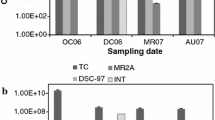Abstract
The brine shrimp, Artemia is the dominant macrozooplankton present in many hypersaline environments. Artemia urmiana is the only macroscopic organism in Urmia Salt Lake (Iran), and the high salinity of the lake makes it a suitable environment for halophilic archaea too. Because of common environment for Artemia and extreme halophiles; this investigation is concentrated on studying the relationship between Artemia and halophilic archaea in Urmia Lake. In this study first the procedure of arhaea isolation was done. Then, isolated strains were sub-cultured and DNA was extracted and amplified by PCR using specific primers for amplifying archaeal 16S rRNA. The amplified archeal DNA fragments were purified, and sequenced. 16S rRNA sequences were compared to known sequences using the NCBI BLAST program. Sequences relating to Halorubrum, Haloarcula and Halobacterium species were identified in Urmia Salt Lake water and Artemia adults and the phylogenetic tree of different species was constructed. Only Halorubrum species were present in association with Artemia. They belong to Halobacteriaceae family of archeae which are isolated from different salt lakes in different parts of world and we could show their existence in adult Artemia, another organism living in hypersaline enviroments.
Similar content being viewed by others
References
Benlloch, S., Acinas, S., Antón, J., López-López, A., Luz, S., and Rodriguez-Valera, F., Archaeal biodiversity in crystallizer ponds from a solar saltern: culture versus PCR, Microb. Ecol., 2001, vol. 41, pp. 12–19.
Bowman, J.P., McCammon, S.A., Rea, S.M., and McMeekin, T.A., The microbial composition of three limnologically disparate hypersaline Antarctic lakes, FEMS Microbiol. Lett., 2000, vol. 183, pp. 81–88.
Castillo, A., Gutiérrez, M., Kamekura, M., Xue, Y., Ma, Y., Cowan, D., Jones, B., Grant, W., and Ventosa, A., Halorubrum orientale sp. nov., a halophilic archaeon isolated from Lake Ejinor, Inner Mongolia, China, Int. J. Syst. Evol. Microbiol., 2006, vol. 56, pp. 2559–2563.
Eimanifar, A. and Mohebbi, F., Urmia Lake (northwest Iran): a brief review, Saline Systems, 2007, vol. 3, pp. 1–8.
Fazeli, Z. and Azari-Takami, G., The best time and concentration for yeast probiotic enrichment of Artemia urmiana Nauplii, Pakistan J. Biol. Sci., 2006, vol. 9, pp. 2159–2161.
Gomez-Gil, B., Thompson, F., Thompson, C., Garcia-Gasca, A., Roque, A., and Swings, J., Vibrio hispanicus sp. nov., isolated from Artemia sp. and sea water in Spain, Int. J. Syst. Evol. Microbiol., 2004, vol. 54, pp. 261–265.
Lavens, P. and Sorgeloos, P., Manual on the Production and Use of Live Food for Aquaculture, Food and Agriculture Organization (FAO), 1996.
Lizama, C., Monteoliva-Sánchez, M., Suárez-García, A., Roselló-Mora, R., Aguilera, M., Campos, V., and Ramos-Cormenzana, A., Halorubrum tebenquichense sp. nov., a novel halophilic archaeon isolated from the Atacama Saltern, Chile, Int. J. Syst. Evol. Microbiol., 2002, vol. 52, pp. 149–155.
Oren, A., Taxonomy of the family Halobacteriaceae: a paradigm for changing concepts in prokaryote systematics, Int. J. Syst. Evol. Microbiol., 2012, vol. 62, pp. 263–271.
Riddle, M.R., Baxter, B.K., and Avery, B.J., Molecular identification of microorganisms associated with the brine shrimp Artemia franciscana, Aquatic Biosystems, 2013, vol. 9, p. 7.
Sahul Hameed, A., Murthi, B., Rasheed, M., Sathish, S., Yoganandhan, K., Murugan, V., and Jayaraman, K., An investigation of Artemia as a possible vector for white spot syndrome virus (WSSV) transmission to Penaeus indicus, Aquaculture, 2002, vol. 204, pp. 1–10.
Triantaphyllidis, G., Abatzopoulos, T., and Sorgeloos, P., Review of the biogeography of the genus Artemia (Crustacea, Anostraca), J. Biogeography, 1998, vol. 25, pp. 213–226.
Zhang, J.-S., Dong, S.-L., Dong, Y.-W., Tian, X.-L., Cao, Y.-C., Li, Z.-J., and Yan, D.-C., Assessment of the role of brine shrimp Artemia in white spot syndrome virus (WSSV) transmission, Vet. Res. Commun., 2010, vol. 34, pp. 25–32.
Zhang, Z., Schwartz, S., Wagner, L., and Miller, W., A greedy algorithm for aligning DNA sequences, J. Comput. Biol., 2000, vol. 7, pp. 203–214.
Author information
Authors and Affiliations
Corresponding author
Additional information
The article is published in the original.
Rights and permissions
About this article
Cite this article
Rahmani, R., Zarrini, G., Aein, F. et al. Identification of extremely halophilic archaea associated with adult Artemia urmiana . Microbiology 85, 386–388 (2016). https://doi.org/10.1134/S0026261716030127
Received:
Published:
Issue Date:
DOI: https://doi.org/10.1134/S0026261716030127




